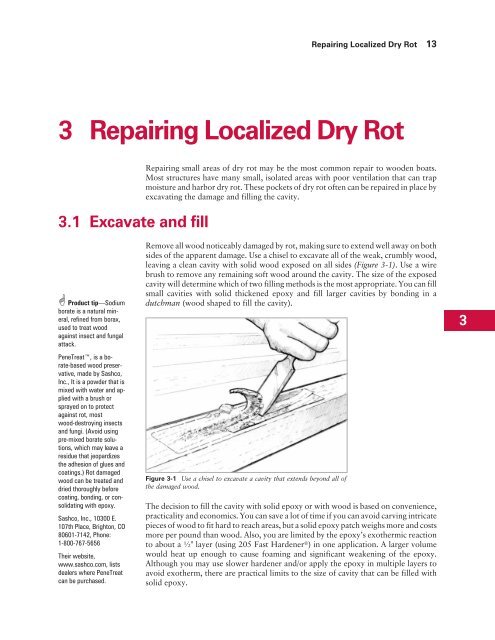Wooden Boat Restoration Repair - WEST SYSTEM Epoxy
Wooden Boat Restoration Repair - WEST SYSTEM Epoxy
Wooden Boat Restoration Repair - WEST SYSTEM Epoxy
You also want an ePaper? Increase the reach of your titles
YUMPU automatically turns print PDFs into web optimized ePapers that Google loves.
3 <strong>Repair</strong>ing Localized Dry Rot<br />
3.1 Excavate and fill<br />
Product tip—Sodium<br />
borate is a natural mineral,<br />
refined from borax,<br />
used to treat wood<br />
against insect and fungal<br />
attack.<br />
PeneTreat, is a borate-based<br />
wood preservative,<br />
made by Sashco,<br />
Inc., It is a powder that is<br />
mixed with water and applied<br />
with a brush or<br />
sprayed on to protect<br />
against rot, most<br />
wood-destroying insects<br />
and fungi. (Avoid using<br />
pre-mixed borate solutions,<br />
which may leave a<br />
residue that jeopardizes<br />
the adhesion of glues and<br />
coatings.) Rot damaged<br />
wood can be treated and<br />
dried thoroughly before<br />
coating, bonding, or consolidating<br />
with epoxy.<br />
Sashco, Inc., 10300 E.<br />
107th Place, Brighton, CO<br />
80601-7142, Phone:<br />
1-800-767-5656<br />
Their website,<br />
www.sashco.com, lists<br />
dealers where PeneTreat<br />
can be purchased.<br />
<strong>Repair</strong>ing Localized Dry Rot 13<br />
<strong>Repair</strong>ing small areas of dry rot may be the most common repair to wooden boats.<br />
Most structures have many small, isolated areas with poor ventilation that can trap<br />
moisture and harbor dry rot. These pockets of dry rot often can be repaired in place by<br />
excavating the damage and filling the cavity.<br />
Remove all wood noticeably damaged by rot, making sure to extend well away on both<br />
sides of the apparent damage. Use a chisel to excavate all of the weak, crumbly wood,<br />
leaving a clean cavity with solid wood exposed on all sides (Figure 3-1). Use a wire<br />
brush to remove any remaining soft wood around the cavity. The size of the exposed<br />
cavity will determine which of two filling methods is the most appropriate. You can fill<br />
small cavities with solid thickened epoxy and fill larger cavities by bonding in a<br />
dutchman (wood shaped to fill the cavity).<br />
Figure 3-1 Use a chisel to excavate a cavity that extends beyond all of<br />
the damaged wood.<br />
The decision to fill the cavity with solid epoxy or with wood is based on convenience,<br />
practicality and economics. You can save a lot of time if you can avoid carving intricate<br />
pieces of wood to fit hard to reach areas, but a solid epoxy patch weighs more and costs<br />
more per pound than wood. Also, you are limited by the epoxy’s exothermic reaction<br />
to about a ½" layer (using 205 Fast Hardener ® ) in one application. A larger volume<br />
would heat up enough to cause foaming and significant weakening of the epoxy.<br />
Although you may use slower hardener and/or apply the epoxy in multiple layers to<br />
avoid exotherm, there are practical limits to the size of cavity that can be filled with<br />
solid epoxy.<br />
3
















